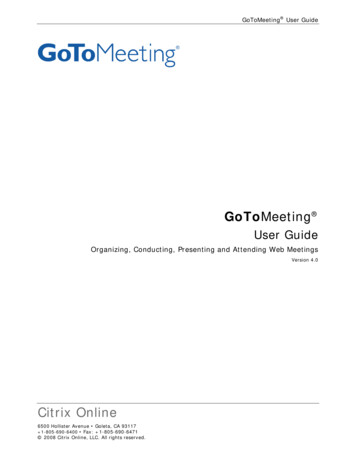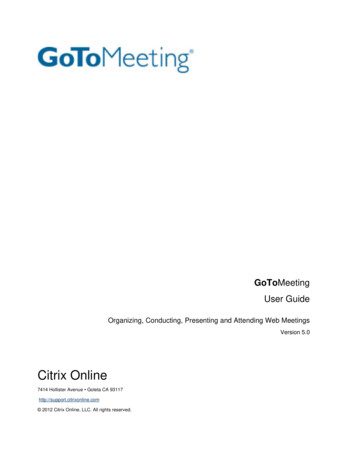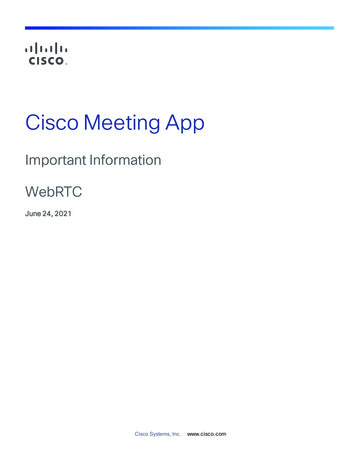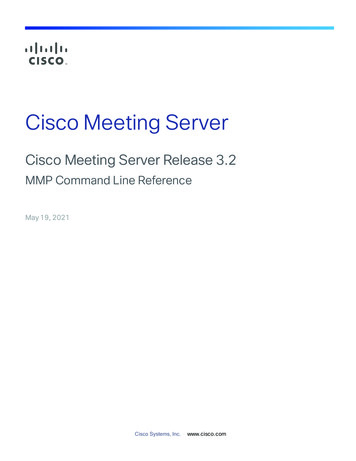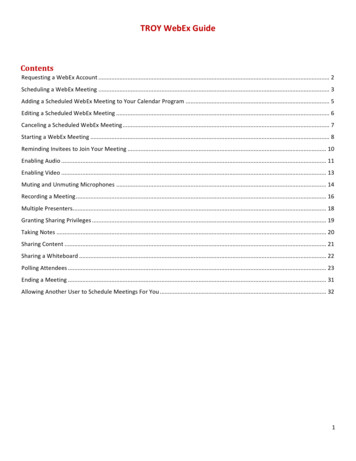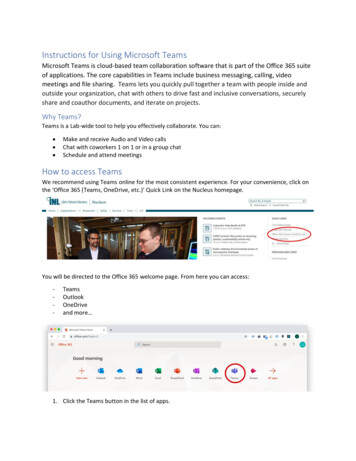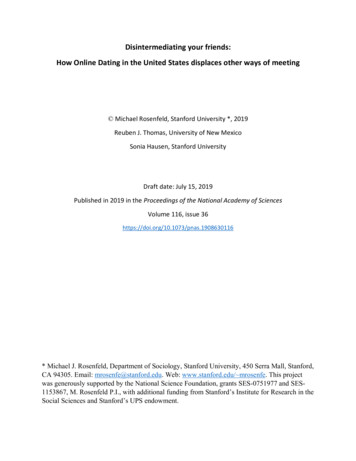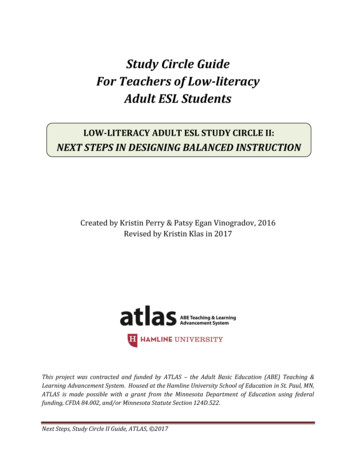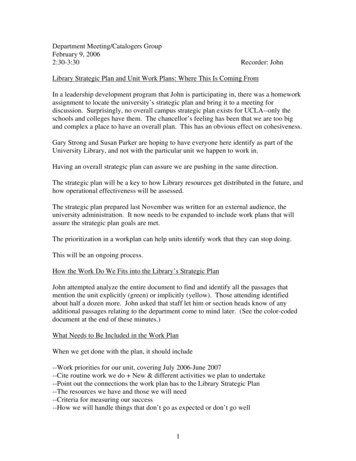
Transcription
Department Meeting/Catalogers GroupFebruary 9, 20062:30-3:30Recorder: JohnLibrary Strategic Plan and Unit Work Plans: Where This Is Coming FromIn a leadership development program that John is participating in, there was a homeworkassignment to locate the university’s strategic plan and bring it to a meeting fordiscussion. Surprisingly, no overall campus strategic plan exists for UCLA--only theschools and colleges have them. The chancellor’s feeling has been that we are too bigand complex a place to have an overall plan. This has an obvious effect on cohesiveness.Gary Strong and Susan Parker are hoping to have everyone here identify as part of theUniversity Library, and not with the particular unit we happen to work in.Having an overall strategic plan can assure we are pushing in the same direction.The strategic plan will be a key to how Library resources get distributed in the future, andhow operational effectiveness will be assessed.The strategic plan prepared last November was written for an external audience, theuniversity administration. It now needs to be expanded to include work plans that willassure the strategic plan goals are met.The prioritization in a workplan can help units identify work that they can stop doing.This will be an ongoing process.How the Work Do We Fits into the Library’s Strategic PlanJohn attempted analyze the entire document to find and identify all the passages thatmention the unit explicitly (green) or implicitly (yellow). Those attending identifiedabout half a dozen more. John asked that staff let him or section heads know of anyadditional passages relating to the department come to mind later. (See the color-codeddocument at the end of these minutes.)What Needs to Be Included in the Work PlanWhen we get done with the plan, it should include--Work priorities for our unit, covering July 2006-June 2007--Cite routine work we do New & different activities we plan to undertake--Point out the connections the work plan has to the Library Strategic Plan--The resources we have and those we will need--Criteria for measuring our success--How we will handle things that don’t go as expected or don’t go well1
--Description of the process used to come up with this work plan How we will generatethe next one.A Process We Could Follow for Developing Our Unit Work PlanCataloging & Metadata Center staff agreed with a proposed plan to (1) have all staffbrainstorm the content of a document, first the work we do, then the ideas for what we’dlike to accomplish in FY07 (2) have Section Heads take this input and develop adocument for staff to react to in a subsequent meeting in March.There’s no template to follow. AULs will sign off on unit work plans submitted.It will be possible to view on the Staff Intranet what other units write.Coordination with other units is possible and desirable.Example: It is likely Stephen Davison will consult about digital library metadata plans.All the standing groups in the Library that meet will be asked to develop a work plan.What Are “Individual Work Plans” About?These will describe the work individuals will be doing in support of the Unit work plan.We need to develop the unit work plan first as a framework.We will learn more about individual work plans later. They can be quite short.Updating of job descriptions, to reflect the work actually being done currently, issomething that we might do as part of this process.BrainstormingLouise suggested starting at high level view of what we do. John then asked how staffwould describe to non-Library friends the type of work they do for the Library. Theresulting brainstorm session covered both general mission-statement types of responsesas well as descriptions of the various types of work we do. Sara’s transcription of theflipcharts is below. In section meetings to be held in the last half of February, staff willcontribute ideas of what they would like to see their section and/or departmentaccomplish next fiscal year. Section Heads will work with that input.What do we do/what are we?Facilitate accessPulsing heart of the libraryTreasure of languages and knowledge that creates access to the collections of the libraryTrainers for technical services/the library staff2
We are the ones who supply/are responsible for the rich underlying metadata on whichservices are builtWe organize and provide accessProcess materials in a timely fashionEnsure accuracy of records that facilitate accessCenter for organizing information for people to access and retrieveProvide expertise—in partnership—for organizing can help build effective allianceswith others on campus [outside the library] collaboration with othersSource of cataloging/metadata for others we get their metadata in returnLeadership within local, regional, and national contextCollaboration with other units within the library (e.g., to develop bindery procedures,serials check-in procedures, etc.)Promote visibility of library through participationHuge part of the library is the catalogConstant striving to eliminate backlogsUse power of technology to get increasing amount of work done (facilitate efficiency,e.g., macros)We do reference work, interact with faculty, help users find things in the catalogMaintain collection (e.g., withdrawals)Maintain dynamic index to the collectionProblem solving through revising the catalogEnhance existing OCLC records—improve the bibliographic universeWe have good ideas, are creative, influential, help set standardsAct as resources to [for?] and provide access to materials [quote from plan]Catalog helps people help themselves (unmediated tool)3
Collaboration with CRL and other institutions to create catalog recordsStatewide ERM supportManage process for inclusion of record sets (supports SP 2.3 bullet on assuringcomparability of metadata)Cataloging is the “Unrivaled intellectual centerpiece of the profession” from John Riemer“A Practitioner’s View of the Education of Catalogers.” CCQ 16(3): 39-48 (1993)4
[Cataloging and Metadata Center’s work mentioned explicitly or implicitly]Strategic Plan2006-09November 15, 20055
Introduction“No other library matches the UCLA Library.”– Jared Diamond, Professor of GeographyThe UCLA Library forms the bedrock supporting all aspects of the university’smission of teaching, research, and public service. As a vibrant enterprise within the academy,the Library’s mission is to provide access to and delivery of information resources to UCLAstudents, faculty, and staff. More actively than ever, the Library: Develops, organizes, and preserves collections for optimal use and provideslinks to remote information sources.Provides services that enable its users to fulfill their academic and intellectualneeds.Engages researchers, scholars, and other users locally, statewide, nationally,and internationally.As one of the top five major academic research libraries in North America, theLibrary must provide world-class collections, services, instructional programs, and facilitiesto support the world-class institution that is UCLA. Relying on its highly skilled staff, theLibrary forges effective partnerships, capitalizes on the use of technology, and aggressivelycontributes to the excellence of UCLA’s students, faculty, staff, and programs. In order tomaintain and pursue this competitive stance, the Library uses its staff, services, and facilitiesto develop, combine, and balance virtual and physical collections in order to preserve theworld’s knowledge, provide present UCLA scholars with the means by which they createnew knowledge, and anticipate the needs of future generations.Chancellor Albert Carnesale has affirmed the Library’s centrality by identifying it as afoundational enterprise that is vital to maintaining and enhancing UCLA’s academic core.The Library has identified four key priorities that define its place at the university’s academicheart and that support all aspects of UCLA’s mission:Priority: Building and Enhancing Research CollectionsTo ensure that collections continue to meet the teaching and research needs ofUCLA faculty and students, future planning must acknowledge budgetary and spaceimperatives along with changes in the format and distribution of scholarly output.Priority: Enhancing ServicesThis involves working closely with users to understand how they use the Library andwhat their needs are, and it also requires transforming the institutional organizationto be able to respond rapidly to these changing needs and usage patterns.Priority: Focusing on Information LiteracyWorking collaboratively with faculty to strengthen undergraduate students’ basicinformation research skills, librarians have created adjunct courses; interactive, online6
tutorials; and library instruction integrated into a major. Efforts must be expanded toassist and support even more faculty, departments, and students.Priority: Targeting the Library as a Physical PlaceOnline resources and services are rapidly expanding, but turnstile counts show nosigns of decreasing usage of the campus libraries. And changing patterns in pedagogyrequire innovative spaces for learning and group study along with space forcollections, research, and individual study.The Library’s strategic plan advances six goals, each supported by outcomes andstrategies, that show its commitment to these key priorities. The vision of the strategic plansustains the chancellor’s Strategy for Greatness by concentrating on the Library’s excellenceas a source of the university’s excellence. The plan integrates the Library’s support of keyuniversity initiatives to enhance interdisciplinary activities and to develop an internationalfocus. And the plan places the Library in a leadership position within the scholarlycommunity with regard to developing and advancing new models for dynamic researchcollections, services, and spaces.“All of us at UCLA treasure the legacy that is the UCLALibrary. With its distinguished collections, technologicallyadvanced facilities, and superb programs, it is an intellectuallink between the campus and the global community.”– Albert Carnesale, Chancellor7
UCLA LIBRARY GOALS, 2006-09A.Transform the CollectionThe UCLA Library will transform its collection from a stand-alone, comprehensiveresearch collection to a dynamic collection that is interdependent with and complementaryto other collections, while continuing to sustain scholarship and teaching at the highest level.Print and digital research collections will be redefined to make them interdependent andcomplementary to, not competitive and redundant with, those of other great researchlibraries. This will ensure that scholars and students have access to the deepest and broadestholdings both in traditional formats and through new media.“How could there be so much information available athand?(I was a little amazed!)”– Comment from undergraduate participant in1.RationaleUCLA has achieved international renown for the excellence of its academic program,and an essential element of that success has been the UCLA Library. Broad and deepcollections are vital to high-quality research, teaching, and learning across all disciplines, andworld-class collections attract and keep the best faculty and graduate students. However,rising costs for both traditional and electronic content, ever-increasing numbers of scholarlypublications in both core areas and new fields, and increasing demand for access to newforms of knowledge have jeopardized the Library’s ability to sustain the excellence andcompetitiveness of its collections. The collections budget has remained flat againstcontinuing double-digit inflation, which undermines efforts to keep Library collectionscompetitive with those of other top universities. Reduced staffing threatens the ability toacquire, catalog, and replace items in a timely fashion.The nature of the scholarly publishing industry, particularly the monographicpublication segment, is such that materials must be obtained when they are published; theymay be out of print and unavailable in less than a year. Thus, collection building must be acontinuous activity that cannot be put on hold for even a short period of time withoutaffecting the collections’ comprehensiveness. The formats of scholarship and publishing andnew forms of information are in demand by scholars and graduate students in all disciplines.Accomplishment: UC Joins Open Content AllianceThe University of California system’s recent agreement to join the OpenContent Alliance – partnering with other universities, content providers, andtechnology companies including Yahoo to digitize out-of-copyright library holdings– capitalizes on this new field of endeavor and will make these educational resourcesmore widely available to the general public as well as scholars.8
While the Library needs to retain highly skilled subject specialists to developtraditional collections, it is building a new cadre of experts who license digital resources,manage huge packages of electronic journal titles, partner with faculty and graduate studentsto develop born and reformatted digital collections. In addition, large-scale digitizationprojects such as the Google Print Initiative compel us to rethink the landscape for both printand digital collection building.The University of California (UC) system and its network of libraries comprise oneof the UCLA Library’s great, and not yet fully utilized, resources. Collaborative projects,shared resources, cooperative purchases, and innovative, novel digital content programsamong UC libraries enable the UCLA Library to maximize financial resources whilebroadening and deepening collections. Working creatively and collaboratively within thebroader UC context offers great possibilities, and its full potential has yet to be realized. Asone of the UC system’s major libraries, the UCLA Library plays a leading role in thestewardship of written culture and the scholarly record and their preservation for posterity.Today’s academy is awash in at-risk digital content. Records of scientific researchare stored in electronic datasets, presented in visualization files, shared in electronicworking papers, and published in electronic journals. Humanities scholars analyzeelectronic texts, create digital models, and generate new forms of digital performance.Historians and social scientists study new communities in cyberspace, track politicalchanges through short-lived campaign Web sites, and bring together virtualencyclopedias and databases of digitized primary materials. Without attention, both therecord of scholarly activity and the materials that support scholarship will disappear. TheLibrary must collaborate with the campus to collect, preserve, and provide access todigital scholarly content created by faculty and students both now and in the future.Accomplishment: Library Offers Digital Content SolutionsThe Library has developed a suite of systems that house and maintaindigital content and can be a powerful partner in solving the challenges of thefuture of digital content. The Digital Library Program can host digital assets inmany forms, including text, photographs, audio files, and archived Web sites.The California Digital Library’s (CDL) eScholarship Repository provides aplatform for digital publishing such as posting working papers, starting a peerreviewed e-journal, or sharing the data that supports a publication. The DigitalPreservation Repository provides a safe location for important digital content,with technology and procedures to guarantee it a long life. The new eLearnStorsystem will allow faculty to share electronic teaching materials with colleagues.2.Outcomes: The Collections in 2009 To sustain UCLA’s scholarship, teaching, and excellence on the highest competitivelevel, the Library leverages its interdependence and collaborations with other researchlibraries and the Center for Research Libraries (CRL). In collaboration with UC, the Library has a state-of-the-art preservation program andstrategy that ensures the perpetual access to print collections and digital assets. Rigorous collection planning and assessment ensures that collections are aligned with9
users’ needs and support established and emerging academic areas and that the Libraryserves as a trustworthy steward of the scholarly record and of university resourcescommitted to it.The Library publicizes its collections both broadly to donors and the community atlarge and strategically to users interested in specific holdings.The Library plays an important collaborative role in developing a campuswide strategyfor the collection and preservation of digital content created by UCLA faculty andstudents.3.Strategies: Collections Objectives 2006-09 Fluid collection-development policies and collection-assessment tools will be createdthat align collection activities and efforts with diversifying and expanding research andinstruction. A collection development strategy will be developed that balances and integrates printand digital resources, whether acquired, licensed, converted, or born digital. Cooperative initiatives and strategies with UC libraries, CRL, and other academiclibraries will be expanded to build shared and shareable digital and print collections. Forexample, the Library will work with other UC libraries to develop the electronicresource management system into a useful tool for collaborative and consortialacquisitions and cooperative cataloging of resources. Funds will be raised to sustain and organize exceptionally strong and broad researchcollections of monographs, including those in foreign vernacular languages, that supportUCLA’s interdisciplinary strategic initiatives and core areas such as international studies. In conjunction with UC and other consortia, the Library will create and implementlicensing strategies and business models for scholarly content that control priceincreases and allow acquisition of the maximum amount of content. The Library will partner with other UC libraries to build a state-of-the-art preservationplan and program. The Library will participate in the Open Content Alliance digitization project, focusingon digitizing unique materials held in UCLA collections. The Library will utilize opportunities provided by Google Scholar, Google Print, andsimilar local, regional, and national projects when they offer efficient and cost-effectiveaccess to materials needed by UCLA students, faculty, and staff. Collections, particularly those in new and interdisciplinary areas, will be featured inexhibits, extensive Web sites, printed and online publications, programs andconferences, and other events.B.Collaborate on Scholarly Publishing“The ballooning costs of academic publications arepreventing faculty members and researchers fromgaining access to the world’s scholarship andknowledge.”– Richard C. Atkinson, former president of the10
The UCLA Library will collaborate with UC-wide and national efforts to end theunsustainable paradigm of scholarly publishing and to create a viable model for thedissemination and distribution of knowledge.1.RationaleThe transformation of scholarly communication and publishing is essential to ensurethe free flow of scholarly information for scholars now and in the future. Several forcespose an imminent threat. First, the commercialization of publishing by both for-profitcompanies and nonprofit societies has led to escalating prices that far exceed the growth oflibrary budgets. This has created a dysfunctional marketplace, particularly in the case ofscientific journals, and these costs have forced libraries to limit book purchases, to canceljournal subscriptions, and to reduce expenditures on specialized research materials. Second,many journals require authors to assign copyright for published works to the publisher,which limits the ability of authors to share their work in other forms and through otheroutlets. Third, academic promotion and tenure review committees continue to rewardpublication in historically prestigious journals, regardless of their price, and undervaluealternative peer-reviewed modes of scholarly publishing.Accomplishment: Steps Taken to Address Scholarly Publishing CrisisTo maintain the free flow of scholarship, fundamental changes must comefrom the faculty and the university. A number of steps have already been taken thatacknowledge the seriousness of the problem and begin to explore and implementpossible solutions. Beginning at the UC system level, the Academic Council hasestablished a Special Committee on Scholarly Communication to steer systemwideAcademic Senate responses, and the Office of the President established an Office ofScholarly Communication as a locus of operational and administrative support. UChas also created and actively promotes the CDL eScholarship Repository for preand postprint journal articles, symposium papers, and research results.2.Outcomes: Scholarly Communication in 2009 As a campus and systemwide leader in the development of strategies and mechanisms toestablish viable models of scholarly communication and publishing, the Library plays avital role in disseminating and preserving scholarly knowledge. The Library partnered with the Office of Research and the Office of IntellectualProperty at UCLA to establish an infrastructure that encourages and supports facultyand graduate students in transforming the system of scholarly publishing. UCLA facultyand administrators have been engaged on this issue through an extensive andunprecedented level of consultation, communication, and collaboration involving theLibrary, the campus, and the UC system. The Library licenses scholarly journal content based on a new model in which the priceof a publisher’s offerings is based on the value of the article as determined by citationsand impact rather than on costs determined by the publisher. The CDL eScholarship Repository has matured into a multifunctional repository ofchoice for UCLA and UC faculty scholarship and research including pre- and postprintarticles, seminar and conference papers, monographs, journals, datasets, and faculty11
3. C.electronic records. Services of UCLA University Archives have been redefined tocapture, preserve, and deliver the electronic records and research of faculty.UCLA librarians are influential participants in the national arena in developing expertise,creating policy, and implementing innovative programs for transforming scholarlypublishing.Faculty and administrators are aware of fundamental issues of sustainability and optionsfor disseminating scholarship and collaborate on developing effective and economicallyviable models of scholarly and scientific publishing.The Library infrastructure supports the scholarly communication program, includingassessment, communication, and faculty support. As a main component of thisinfrastructure, the Library sponsors regular symposia that engage faculty and graduatestudents in discussions about major issues including copyright management, openaccess, and self-archiving.Strategies: Scholarly Communication Objectives, 2006-09Accomplishment: UCLA Preserves ScholarshipUCLA has assumed leadership in the scholarly community by participating inthe UC-wide JSTOR paper repository project to provide and guarantee perpetualaccess to materials represented in that database.The UCLA Library will collaborate with other UC campuses to develop a strategy fornegotiating systemwide licenses that reduces the base price of packages and controlsannual cost increases.Working with the UCLA Office of Research, the Library will develop an infrastructurethat supports and encourages faculty to disseminate their research and scholarshipthrough open-access journals and repositories.Partner with campus administrators and departments, the Library will establish a servicethat offers faculty a range of support for managing their digital assets and intellectualproperty; services will include assistance with copyright management, e-reserves andcourse management policies, self archiving and repository usage, and advice regardingopen-access journals.The Library will create an electronic publishing outlet/service for graduate andundergraduate student papers that educates students about issues of intellectualproperty and dissemination of scholarship in open-access models.The Library will develop and implement a systematic plan and mechanism foridentifying and tracking faculty who support alternative methods of scholarlycommunication, deposit materials in institutional repositories, and publish in openaccess journals. These trailblazers will then be used as models to leverage wider facultyengagement and participation.The Library will develop a metadata set to apply to scholarly journal articles, which willbe used to inform faculty and administrators of the costs, value, and impact of scholarlyjournal and open-access options.Make Specialized Collections AccessibleThe Library will guarantee that the totality of its specialized and unique research12
resources are identifiable, accessible, and available for researchers and students.“There’s a huge amount of material here. It’s anincredible gift for me and my students to look at and touse.”– UCLA History Professor Joan Waugh, talking aboutcirculating and special collections in the Charles E.1.RationaleAs a foundation of UCLA’s academic enterprise, the Library underpins theuniversity’s reputation as one of the nation’s finest research institutions, public or private.Its specialized and unique research collections give UCLA a competitive advantage overcomparable regional, national, and international institutions, and as the core of generalcollections becomes increasingly duplicative among libraries and more available online, theserare and specialized holdings assume an even greater importance in defining excellence. Therichness and range of specialized research resources and unique materials range across alldisciplines and reflect materials in hundreds of languages from all over the world. Thesematerials support research in cutting-edge scientific fields such as stem-cell research,strategic interdisciplinary fields such as genetics and society, and vital international areas asAsian studies. Faculty and graduate student research and teaching encompass a broad,complex range of topics that rely on these resources, which are found in the Library's specialcollections libraries, its main circulating collections, and its virtual digital library.Accomplishment: Library Collects Unique East Asian MaterialsThe Richard C. Rudolph East Asian Library houses some two hundredunique Chinese, Japanese, and Korean vernacular-language manuscripts.The Library’s rich holdings of rare books, manuscripts, and photographs are essentialprimary sources for research in the humanities and must be findable by and accessible tofaculty and graduate students. Many holdings remain hidden and inaccessible because thepace of acquiring materials has outstripped the ability to process them.Though the problem of hidden collections is one shared by many libraries, thesituation at UCLA is particularly acute; many manuscript collections are unprocessed, andrare-book and specialized-subject backlogs are among the largest in the country. Makingthese holdings available digitally presents an additional challenge: the vast majority of theLibrary’s unique collections are not digitized, and their digitization would require copyrightclearance, creation of metadata, adherence to descriptive standards, and preservation ofdigital files, all of which involve associated costs.In addition, unique and specialized collections will come to the Library in the futurein digital form. New policies, procedures, and infrastructure will be required to keep thesecollections from becoming tomorrow’s hidden treasures.2.Outcomes: Specialized Collections in 2009 Easily discoverable existing holdings reveal the Library’s hidden treasures and yield new13
opportunities for scholarship, teaching, recruitment, retention, and collaboration.Processing and cataloging backlogs of materials in all formats have been eliminated.The metadata for all physical and digital collections are comparable enough to facilitatefederated searching.The Center for Primary Research and Training has expanded to include graduatestudents and special collections materials outside of the humanities and social sciences.This has integrated the Library more firmly into teaching and research and aligned itwith campuswide strategic initiatives focusing on faculty and student recruitment andretention.Digital projects built around rare and specialized research collections highlight theLibrary’s commitment to traditional means and objects of learning while taking fulladvantage of technological innovation and change.The prestige of the Library’s superlative holdings and the need of comparable spaces tohouse them form a key message point in the Library’s capital campaigns.The UCLA Library plays a major role in defining best practices for collecting andmanaging and preserving archival collections in digital form, including the records ofscientific research.3.Strategies: Specialized Collections Objectives, 2006-09 Processing capacity will be increased by leveraging new technologies and committingresources to describe and deliver specialized research materials. New standards and metadata for description and delivery of research materials will beimplemented to maximize access to research collections. The Center for Primary Research and Training will remain a top fundraising priority. The creation of digital assets will be integrated into the processing flow of specialcollections materials, and a digital asset management strategy will be adopted thatensures the widest possible access to the Library’s unique and specialized collections. The project to convert all special collections finding aids to electronic format throughthe Online Archive of California w
Library Strategic Plan and Unit Work Plans: Where This Is Coming From In a leadership development program that John is participating in, there was a homework assignment to locate the university’s strategic plan and bring it to a meeting for discussion. Surprisingly, no overall campus strategic
